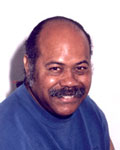
Artist Biography
Artist Monticello Miller was born in 1952 in New York City. His mother, Leticia Sostre in an attempt to expand her own artistic career moved her family to Los Angeles in 1954. The smell of turpentine and oil based paint was commonplace for Monticello and it became the inspiration which he would continually draw from.
At an early age Monticello realized that art was not only an expression, but a statement as well. He expanded his artistic interests to include photography as an art form. A young Monticello could be found photographing the streets of Los Angeles and the "Love-ins" at Griffith Park. In the mid 1960's his political consciousness was challenged. He demonstrated against the Vietnam War with Jane Fonda and performed in coffee houses such as "The Bridge," with poet Charles Bukowski and Wanda Coleman. Highlights of this period included conversing with Jimi Hendrix at a hippy commune in 1967at the age of 15 and witnessing the assassination of Robert F. Kennedy at the Ambassador Hotel at the age of 16.
The renaissance of the 1960's forged Monticello Miller with a passionate, emotional commitment to utilize art as a healing tool. Through the Seventies and into the Eighties, Monticello was one of the persistent minority artists who would be able to penetrate into the well-established art galleries that were finding it hard to represent and promote minority artists. Monticello was constantly reinventing himself and along the way finding new ways to showcase his art photography, such as his one-man show entitled "Expanding Wall" held at the Dorothy Chandler Pavillion Music Center in 1979. Monticello's resourcefulness gave him more control over his artistic career and a deeper commitment to his artistic statements. The challenges that he would overcome were to provide him with the tools to move him forward and set the pace into the innovative Nineties.
In 1991, Monticello pulled his resources again to hold an exhibit entitled "Extended Conversations" which was held at the Lankershim Art Center Gallery. This exhibit included poetic synopsis' that described the emotional interpretations of the works which included oil paintings, photography and mixed media. Monticello transcribed each poetic synopsis to Braille allowing the visually impaired community to participate in the exhibit as well. Immediately following this success, Monticello went on to create a Kids At Risk program in which he empowered local graffiti artists by transferring their skills onto oils and canvas. This led to the first Graffiti Art exhibition in 1992 entitled "Masters of the Broken Pieces." This exhibit was voted in by the Los Angeles City Council as part of their 211th birthday celebration for the City of Los Angeles.
Monticello had now captured the attention of other local and international artists living in the Los Angeles area who shared similar ideas that art could be utilized as a healing tool. This led Monticello to direct, curate and produce "MASA '93, L.A. Internationale," an art exhibit inspired by the 1992 racial uprising. This was a multi-cultural exhibition that brought together contemporary artists both locally and internationally to share a common ground.
Monticello describes his interpretation of an artist as, "One who prepares humanity to have the ability to change."
Monticello's artistic statements became, for the next ten years, a string of exhibits that collaborated over four hundred different artists. In 1995, Monticello organized an exhibit entitled "The Year of the Woman" aimed at raising consciousness towards gender. This show featured female and male artists who celebrated the spirit and the idea of the woman through their work.
In 1996 he inspired the City of Burbank with a photographic exhibition and lecture series featuring nine contemporary Latin-American Photographers entitled "Viva Las Photos." This exhibit allowed these Latin-American photographers to share their perceptions of cosmopolitan life through their photographs.
In 2000 Monticello organized "The Contemporary Latino Masters Exhibit" which shared with the Korean community one of the most innovative, dynamic and historical Latino exhibitions. This exhibit was held at the Modern Art Gallery in our little Korea district and featured the works of twelve Latino Artists whose works impacted Los Angeles' cosmopolitan consciousness.
In June of 2001, Monticello organized "Living with L.A. Art: An Acquired Taste" at the EL Pueblo Gallery. This exhibit featured 80 local and international artists and gave a recipe for Los Angeles' artistic diversity and international maturity.
In 2002 Monticello opened an exhibit at the Forest Lawn Museum entitled "Eclectic L.A. Celebration Diversity Through Art in L.A.." This exhibit showcased the mosaic complexity of a multi-cultural society and created a porthole through which to enrich the emotions that balance and give strength to the celebration of life. It featured 26 artists from diverse communities around Los Angeles who came to celebrate life and its enrichments.
